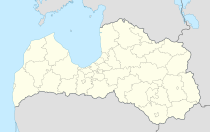Carnikava
| Carnikava ( German : Koivemund) | ||
|---|---|---|
 Help on coat of arms |
|
|
| Basic data | ||
| State : |
|
|
| Landscape: | Livonia ( Latvian : Vidzeme ) | |
| Administrative district : | Carnikava | |
| Coordinates : | 57 ° 8 ' N , 24 ° 16' E | |
| Residents : | 4,015 (Jun 3, 2015) | |
| Area : | 8.2 km² | |
| Population density : | 490 inhabitants per km² | |
| Height : | ||
| Website: | www.carnikava.lv | |
| Post Code: | ||
| ISO code: | ||
Carnikava (German: Koivemund ) is a place in Latvia with 5,640 inhabitants (as of February 2, 2006) and the administrative center of the district of the same name . The place is 25 km north of Riga near the Via Baltica (European route 67) on the Gulf of Riga . To the north of the main town, the river Gauja (English: Livonian Aa , Estonian: Koiva ) flows into the Baltic Sea. There are numerous lakes in the 60% forest area, including the Dzirnezers, which is well developed for tourism .
history
Carnikava is the first time for the year 1211 in the Livonian Chronicle of Henry of Latvia as a gathering place livischer hosts ( Livonian : Sarnikau) mentioned. In the following years Carnikava gained importance as a station on the old trade route between Pernau ( Estonian : Pärnu ) and Riga . In the 19th century Carnikava became an important center of today salmon and lamprey fishing . In 1992 Carnikava, previously part of the Ādaži region , became independent. On March 21, 2006, the Carnikava district (also known as the "Carnikava municipality"; Lat. Carnikavas novads ) was founded, the center of which is the capital of the same name.
Carnikava district
As of March 21, 2006, the Carnikava district comprises seven localities: Carnikava, Kalngale , Garciems , Garupe , Gauja and Lilaste . The total area of the Carnikava District consists of 60% forest, 24% agricultural area and 6% water surface. The Piejūra Nature Park , which covers the wooded coastal area, is worth seeing . In summer, the area plays an important role as a local recreation center and holiday region for the urban population of Riga.
Famous sons and daughters of the place
- Friedrich Mein , pastor and first author of a folk song in Latvian
- Christian Heinrich Pander (1794–1865), embryologist, zoologist and paleontologist
literature
- Astrīda Iltnere (ed.): Latvijas Pagasti, Enciklopēdija. Preses Nams, Riga 2002, ISBN 9984-00-436-8 .
